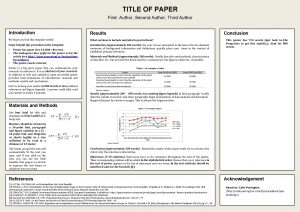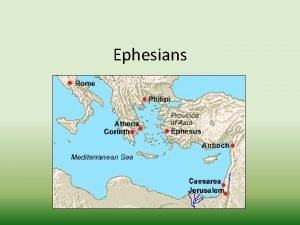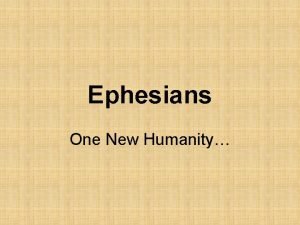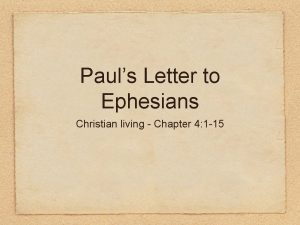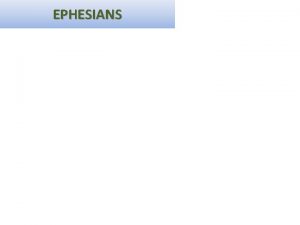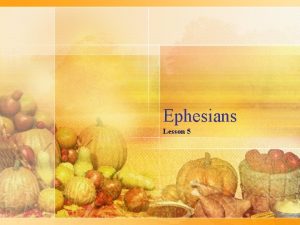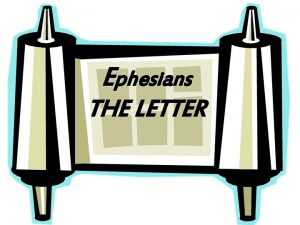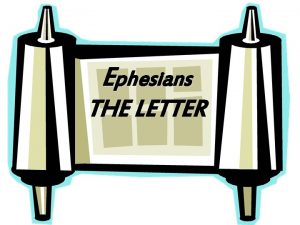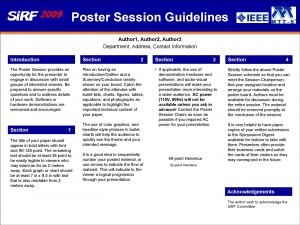Ephesians Author and Date Paul is indicated as












- Slides: 12

Ephesians

Author and Date Paul is indicated as author in the opening salutation (1: 1; 3: 1). The letter was written from prison in Rome (Acts 28: 16– 31) sometime between a. d. 60– 62 and is, therefore, often referred to as a prison epistle (along with Philippians, Colossians, and Philemon). It was probably composed at the same time as Colossians (major thematic and grammatical overlap) and initially sent with that epistle and Philemon (Eph. 6: 21, 22; Col. 4: 7, 8).

Awkwardly… The letter may not have been written primarily to the ‘saints in Ephesus’ (1: 1). • The words ‘in Ephesus’ are not found here in the earliest manuscripts, and 1: 15 and 3: 1– 3 assume that Paul and the majority of his readers have heard reports of each other, but not necessarily more. • The letter also ends without the customary personal greetings which we would expect in a letter addressed to Ephesus (cf. Rom. 16; Col. 4: 10– 17). These features have suggested to many that Ephesians was actually intended as a circular letter. Perhaps it was written for the churches along or near the road Tychicus would have taken from Ephesus to Colosse, including Magnesia, Tralles, Hierapolis and Laodicea. Consequently, Ephesians may be the letter Col. 4: 16 refers to as the ‘letter from Laodicea’.

Background and Setting It is likely that the gospel was first brought to Ephesus by Priscilla and Aquila (see Acts 18: 26) who were left there by Paul on his second missionary journey (Acts 18: 18, 19). The church, was later strengthened by Paul on his third missionary journey (Acts 19) and was pastored by him for some 3 years (during which time Paul wrote to Corinth). Ephesus is located on the SW coast of modern Turkey (Asia). The city of Ephesus was well known for its magnificent temple of Artemis, or Diana, one of the 7 wonders of the ancient world. It was also an important political, educational, and commercial center, ranking with Alexandria in Egypt, and Antioch of Pisidia, in southern Asia Minor.

Cosmic Reconciliation • The present and future reality in which all things created are brought back under the authority and unified in the peace of Christ. • In Ephesians a dominant theme is cosmic reconciliation in Christ (Eph. 1: 9– 10, 20– 23; 2: 10– 22, and 3: 6). – The OT maintained that the universe was the creation of God who was one, without peer or rival, and all was initially in harmony with him (cf. Dt. 6: 4. , recited daily by Jews, and Gn. 1). – According to Jewish understanding, however, the willing subjection of all things to God dissolved into a rebellion of competing claims. People became progressively alienated from God and then from each other (eg. the exclusion from the Garden of Eden, the murder of Abel, and the fiasco of Babel). • The day of the Lord was seen as the day when God would subject all competing powers to himself and thus restore the universe to harmony.

• Ephesians teaches that cosmic reconciliation has been begun in Christ and will be consummated in him. – the old division of humanity into Jew and Gentile has been overcome (2: 10– 16). – the older alienation of humankind from God surmounted too (2: 17– 18). – Christ has begun to ‘fill’ and unite the universe (4: 10), bringing peace. • These things are experienced by those united with him, namely by believers. This leads to an awesome, majestic vision of the church. The universal church of Jews and Gentiles is the place Jesus fills (1: 23); it is the place where the world and the powers are to see the cosmic reconciliation already under way (3: 6– 10)

Historical and Theological Themes Two related features of the letter are also especially significant: the focus on ‘the powers of this dark world’ (6: 12), and the emphasis on present salvation. Whereas in Corinthians Paul stresses the not-yet-ness of salvation (they were rather overconfident), in Ephesians Paul stresses the present realization of salvation. • Magical beliefs and the associated fear of spiritual powers was prevalent in Ephesus and the surrounding area, consequently Paul comforts them that they need not fear such powers insisting on the greater power in Christ and in believers united with him (see on 1: 19– 23; 2: 1– 7; 3: 9– 10, 15– 16, 20; 4: 8; 6: 10– 17).

The Mystery Another key theme of the letter is the mystery (meaning a heretofore unrevealed truth) of the church, which is “that the Gentiles should be fellow heirs, of the same body, and partakers of His promise in Christ through the gospel” (3: 6), a truth completely hidden from the OT saints (cf. 3: 5, 9), though they would be blessed through them (cf. Abrahamic Covenant). All believers in Jesus Christ, the Messiah, are equal before the Lord as His children and as citizens of His eternal kingdom, a marvelous truth that only believers of this present age possess. Paul also speaks of the mystery of the church as the bride of Christ (5: 32; cf. Rev. 21: 9).

The Body A major truth emphasized is that of the church as Christ’s present spiritual, earthly body, also a distinct and formerly unrevealed truth about God’s people. This metaphor depicts the church, not as an organization, but as a living organism composed of mutually related and interdependent parts. Christ is Head of the body and the Holy Spirit is its lifeblood, as it were. The body functions through the faithful use of its members’ various spiritual gifts, sovereignly and uniquely bestowed by the Holy Spirit on each believer.

The Riches and Blessings In Christ • “riches” is used 5 times in this letter “the riches of His [God’s] grace (1: 7), “the unsearchable riches of Christ” (3: 8), and “the riches of His glory” (3: 16). • “grace” is used 12 times Their riches in Christ are based on His grace (1: 2, 6, 7; 2: 7), His peace (1: 2), His will (1: 5), His pleasure and purpose (1: 9), His glory (1: 12, 14), His calling and inheritance (1: 18), His power and strength (1: 19; 6: 10), His love (2: 4), His workmanship (2: 10), His Holy Spirit (3: 16), His offering and sacrifice (5: 2), and His armor (6: 11, 13). • “glory” 8 times • “fullness” or “filled” 6 times Paul admonishes believers to “be filled with all the fullness of God” (3: 19), to “come to the unity of the faith and of the knowledge of the Son of God, to a perfect man, to the measure of the stature of the fullness of Christ” (4: 13), and to “be filled with the Spirit” (5: 18). • and the key phrase “in Christ” (or “in Him”) 12 times.

Interpretive Challenges The general theology of Ephesians is direct, unambiguous, and presents no ideas or interpretations whose meanings are seriously contended. There are, however, some texts that require careful thought to rightly interpret, namely: 1) 2: 8, in which one must decide if the salvation or the faith is the gift; 2) 4: 5, in which the type of baptism must be discerned; and 3) 4: 8, in its relationship to Ps. 68: 18.

I. II. III. IV. V. VIII. IX. X. XI. Outline A. B. C. D. E. F. A. B. C. D. A. B. C. A. B. Salutation (1: 1, 2) God’s Purpose for the Church (1: 3– 3: 13) Predestination in Christ (1: 3– 6 a) Redemption in Christ (1: 6 b– 10) Inheritance in Christ (1: 11– 14) Resources in Christ (1: 15– 23) New Life in Christ (2: 1– 10) Unity in Christ (2: 11– 3: 13) God’s Fullness for the Church (3: 14– 21) God’s Plan for Faithful Living in the Church (4: 1– 6) God’s Son Endows and Builds the Church (4: 7– 16) God’s Pattern and Principles for Members of the Church (4: 17– 32) God’s Standards for Faithfulness in the Church (5: 1– 21) Walking in Love (5: 1– 7) Living in Light (5: 8– 14) Walking in Wisdom and Sobriety (5: 15– 18 a) Filled with God’s Spirit (5: 18 b– 21) God’s Standards for Authority and Submission in the Church (5: 22– 6: 9) Husbands and Wives (5: 22– 33) Parents and Children (6: 1– 4) Employers and Employees (6: 5– 9) God’s Provision for His Children’s Spiritual Battles (6: 10– 17) The Believer’s Warfare (6: 10– 13) The Believer’s Armor (6: 14– 17) God’s Appeal for Prayer in the Church (6: 18– 20) Benediction (6: 21– 24)
 First author second author third author
First author second author third author Date of ephesians
Date of ephesians Awake united states meaning
Awake united states meaning Record date dividends
Record date dividends Ex date for dividend
Ex date for dividend Author of ephesians
Author of ephesians Letter of st paul to the ephesians chapter 4
Letter of st paul to the ephesians chapter 4 I can perform operations on functions
I can perform operations on functions Indicated altitude
Indicated altitude Loren french
Loren french Engine performance parameters
Engine performance parameters Flynn effect psychology
Flynn effect psychology Find the indicated angle measure
Find the indicated angle measure
